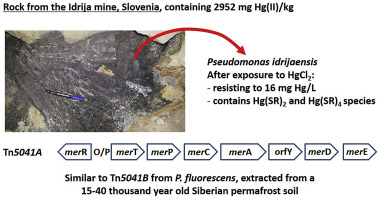当前位置:
X-MOL 学术
›
Chemosphere
›
论文详情
Our official English website, www.x-mol.net, welcomes your
feedback! (Note: you will need to create a separate account there.)
The chemical species of mercury accumulated by Pseudomonas idrijaensis, a bacterium from a rock of the Idrija mercury mine, Slovenia.
Chemosphere ( IF 8.1 ) Pub Date : 2020-01-22 , DOI: 10.1016/j.chemosphere.2020.126002 Jean-Paul Bourdineaud 1 , Goran Durn 2 , Bojan Režun 3 , Alain Manceau 4 , Jasna Hrenović 5
Chemosphere ( IF 8.1 ) Pub Date : 2020-01-22 , DOI: 10.1016/j.chemosphere.2020.126002 Jean-Paul Bourdineaud 1 , Goran Durn 2 , Bojan Režun 3 , Alain Manceau 4 , Jasna Hrenović 5
Affiliation

|
A mercury-resistant bacterial strain has been isolated from a rock of the Idrija mercury mine in Slovenia. The rock had 19 g carbon and 2952 mg mercury (Hg) per kg. Mass spectrometry and DNA sequencing showed that the bacterium belongs to the Pseudomonas genus. It is called Pseudomonas idrijaensis. This bacterial strain is sensitive to methylmercury (MeHg) like the reference P. aeruginosa strain PAO1, and is resistant to divalent mercury (Hg(II)) in contrast to PAO1. This difference could be attributed to the presence of the mer operon yet deprived of the merB gene encoding the organomercurial lyase, on the basis of whole genome sequencing. The P. idrijaensis mer operon displays the RTPCADE organization and is contained in the Tn5041 transposon. This transposon identified here occurs in other Gram-negative Hg-resistant strains isolated from mercury ores, aquatic systems and soils, including Pseudomonas strains from 15,000 to 40,000 years old Siberian permafrost. When P. idrijaensis was exposed to mercury chloride, two intracellular Hg species were identified by high energy-resolution XANES spectroscopy, a dithiolate Hg(SR)2 and a tetrathiolate Hg(SR)4 complex. P. idrijaensis had a much higher [Hg(SR)2]/[Hg(SR)4] molar ratio than bacteria lacking the mer operon when exposed to 4 μg Hg2+/L - resulting in an intracellular accumulation of 4.3 μg Hg/g dw. A higher amount of the Hg(SR)2 complex provides a chemical signature for the expression of the dicysteinate Mer proteins in response to mercury toxicity.
中文翻译:

斯洛文尼亚伊德里亚汞矿岩石中的细菌假单胞菌(Pseudomonas idrijaensis)积累的汞的化学物种。
从斯洛文尼亚Idrija汞矿的一块岩石中分离出了一种抗汞细菌菌株。岩石的碳含量为19克/千克,含汞量为2952毫克。质谱和DNA测序表明该细菌属于假单胞菌属。它被称为伊氏假单胞菌。该细菌菌株像铜绿假单胞菌菌株PAO1一样对甲基汞(MeHg)敏感,与PAO1相比,对二价汞(Hg(II))具有抗性。在全基因组测序的基础上,该差异可以归因于mer操纵子的存在,但是mer操纵子的存在被剥夺了编码有机汞裂解酶的merB基因。P. idrijaensis mer操纵子显示RTPCADE组织,并包含在Tn5041转座子中。此处确定的该转座子发生在从汞矿石,水生系统和土壤中分离出来的其他革兰氏阴性抗Hg菌株中,包括15,000至40,000年的西伯利亚多年冻土层的假单胞菌菌株。当P. idrijaensis暴露于氯化汞时,通过高能分辨XANES光谱法鉴定出两种细胞内汞物种:二硫代Hg(SR)2和四硫代Hg(SR)4复合物。当暴露于4μgHg2 + / L时,伊德里亚贾斯疟原虫的[Hg(SR)2] / [Hg(SR)4]摩尔比比没有mer操纵子的细菌高得多-导致细胞内积累4.3μgHg / g dw。较高含量的Hg(SR)2复合物为双半胱氨酸Mer蛋白表达对汞的毒性提供了化学特征。000岁的西伯利亚永久冻土。当P. idrijaensis暴露于氯化汞时,通过高能分辨XANES光谱法鉴定出两种细胞内汞物种:二硫代Hg(SR)2和四硫代Hg(SR)4复合物。当暴露于4μgHg2 + / L时,伊德里亚贾斯疟原虫的[Hg(SR)2] / [Hg(SR)4]摩尔比比没有mer操纵子的细菌高得多-导致细胞内积累4.3μgHg / g dw。较高含量的Hg(SR)2复合物为双半胱氨酸Mer蛋白表达对汞的毒性提供了化学特征。000岁的西伯利亚永久冻土。当P. idrijaensis暴露于氯化汞时,通过高能分辨XANES光谱法鉴定出两种细胞内汞物种:二硫代Hg(SR)2和四硫代Hg(SR)4复合物。当暴露于4μgHg2 + / L时,伊德里亚贾斯疟原虫的[Hg(SR)2] / [Hg(SR)4]摩尔比比没有mer操纵子的细菌高得多-导致细胞内积累4.3μgHg / g dw。较高含量的Hg(SR)2复合物为响应于汞毒性的半胱氨酸Mer蛋白的表达提供了化学特征。当暴露于4μgHg2 + / L时,伊德里雅族的[Hg(SR)2] / [Hg(SR)4]摩尔比要比缺少mer操纵子的细菌高得多-导致细胞内积累4.3μgHg / g dw。较高含量的Hg(SR)2复合物为双半胱氨酸Mer蛋白表达对汞的毒性提供了化学特征。当暴露于4μgHg2 + / L时,伊德里雅族的[Hg(SR)2] / [Hg(SR)4]摩尔比要比缺少mer操纵子的细菌高得多-导致细胞内积累4.3μgHg / g dw。较高含量的Hg(SR)2复合物为双半胱氨酸Mer蛋白表达对汞的毒性提供了化学特征。
更新日期:2020-01-22
中文翻译:

斯洛文尼亚伊德里亚汞矿岩石中的细菌假单胞菌(Pseudomonas idrijaensis)积累的汞的化学物种。
从斯洛文尼亚Idrija汞矿的一块岩石中分离出了一种抗汞细菌菌株。岩石的碳含量为19克/千克,含汞量为2952毫克。质谱和DNA测序表明该细菌属于假单胞菌属。它被称为伊氏假单胞菌。该细菌菌株像铜绿假单胞菌菌株PAO1一样对甲基汞(MeHg)敏感,与PAO1相比,对二价汞(Hg(II))具有抗性。在全基因组测序的基础上,该差异可以归因于mer操纵子的存在,但是mer操纵子的存在被剥夺了编码有机汞裂解酶的merB基因。P. idrijaensis mer操纵子显示RTPCADE组织,并包含在Tn5041转座子中。此处确定的该转座子发生在从汞矿石,水生系统和土壤中分离出来的其他革兰氏阴性抗Hg菌株中,包括15,000至40,000年的西伯利亚多年冻土层的假单胞菌菌株。当P. idrijaensis暴露于氯化汞时,通过高能分辨XANES光谱法鉴定出两种细胞内汞物种:二硫代Hg(SR)2和四硫代Hg(SR)4复合物。当暴露于4μgHg2 + / L时,伊德里亚贾斯疟原虫的[Hg(SR)2] / [Hg(SR)4]摩尔比比没有mer操纵子的细菌高得多-导致细胞内积累4.3μgHg / g dw。较高含量的Hg(SR)2复合物为双半胱氨酸Mer蛋白表达对汞的毒性提供了化学特征。000岁的西伯利亚永久冻土。当P. idrijaensis暴露于氯化汞时,通过高能分辨XANES光谱法鉴定出两种细胞内汞物种:二硫代Hg(SR)2和四硫代Hg(SR)4复合物。当暴露于4μgHg2 + / L时,伊德里亚贾斯疟原虫的[Hg(SR)2] / [Hg(SR)4]摩尔比比没有mer操纵子的细菌高得多-导致细胞内积累4.3μgHg / g dw。较高含量的Hg(SR)2复合物为双半胱氨酸Mer蛋白表达对汞的毒性提供了化学特征。000岁的西伯利亚永久冻土。当P. idrijaensis暴露于氯化汞时,通过高能分辨XANES光谱法鉴定出两种细胞内汞物种:二硫代Hg(SR)2和四硫代Hg(SR)4复合物。当暴露于4μgHg2 + / L时,伊德里亚贾斯疟原虫的[Hg(SR)2] / [Hg(SR)4]摩尔比比没有mer操纵子的细菌高得多-导致细胞内积累4.3μgHg / g dw。较高含量的Hg(SR)2复合物为响应于汞毒性的半胱氨酸Mer蛋白的表达提供了化学特征。当暴露于4μgHg2 + / L时,伊德里雅族的[Hg(SR)2] / [Hg(SR)4]摩尔比要比缺少mer操纵子的细菌高得多-导致细胞内积累4.3μgHg / g dw。较高含量的Hg(SR)2复合物为双半胱氨酸Mer蛋白表达对汞的毒性提供了化学特征。当暴露于4μgHg2 + / L时,伊德里雅族的[Hg(SR)2] / [Hg(SR)4]摩尔比要比缺少mer操纵子的细菌高得多-导致细胞内积累4.3μgHg / g dw。较高含量的Hg(SR)2复合物为双半胱氨酸Mer蛋白表达对汞的毒性提供了化学特征。











































 京公网安备 11010802027423号
京公网安备 11010802027423号